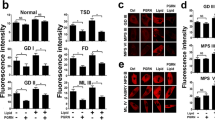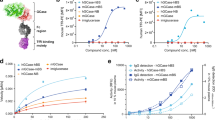Abstract
GM1-gangliosidosis, a lysosomal storage disorder, is associated with ~ 161 missense variants in the GLB1 gene. Affected patients present with β-galactosidase (β-Gal) deficiency in lysosomes. Loss of function in ER-retained misfolded enzymes with missense variants is often due to subcellular mislocalization. Deoxygalactonojirimycin (DGJ) and its derivatives are pharmaceutical chaperones that directly bind to mutated β-Gal in the ER promoting its folding and trafficking to lysosomes and thus enhancing its activity. An Emirati child has been diagnosed with infantile GM1-gangliosidosis carrying the reported p.D151Y variant. We show that p.D151Y β-Gal in patient’s fibroblasts retained < 1% residual activity due to impaired processing and trafficking. The amino acid substitution significantly affected the enzyme conformation; however, p.D151Y β-Gal was amenable for partial rescue in the presence of glycerol or at reduced temperature where activity was enhanced with ~ 2.3 and 7 folds, respectively. The butyl (NB-DGJ) and nonyl (NN-DGJ) derivatives of DGJ chaperoning function were evaluated by measuring their IC50s and ability to stabilize the wild-type β-Gal against thermal degradation. Although NN-DGJ showed higher affinity to β-Gal, it did not show a significant enhancement in p.D151Y β-Gal activity. However, NB-DGJ promoted p.D151Y β-Gal maturation and enhanced its activity up to ~ 4.5% of control activity within 24 h which was significantly increased to ~ 10% within 6 days. NB-DGJ enhancement effect was sustained over 3 days after washing it out from culture media. We therefore conclude that NB-DGJ might be a promising therapeutic chemical chaperone in infantile GM1 amenable variants and therefore warrants further analysis for its clinical applications.







Similar content being viewed by others
References
Araki K, Nagata K (2011) Protein folding and quality control in the ER. Cold Spring Harb Perspect Biol. https://doi.org/10.1101/cshperspect.a007526
Brunetti-Pierri N, Scaglia F (2008) GM1 gangliosidosis: review of clinical, molecular, and therapeutic aspects. Mol Genet Metab 94:391–396. https://doi.org/10.1016/j.ymgme.2008.04.012
Caciotti A et al (2011) GM1 gangliosidosis and morquio B disease: an update on genetic alterations and clinical findings. Biochim Biophys Acta 1812:782–790. https://doi.org/10.1016/j.bbadis.2011.03.018
Case D et al (2012) AMBER 12. University of California, San Francisco
Celej MS, Montich GG, Fidelio GD (2003) Protein stability induced by ligand binding correlates with changes in protein flexibility. Protein Sci 12:1496–1506
Cortez L, Sim V (2014) The therapeutic potential of chemical chaperones in protein folding diseases. Prion 8:197–202. https://doi.org/10.4161/pri.28938
Deodato F et al (2017) The treatment of juvenile/adult GM1-gangliosidosis with Miglustat may reverse disease progression. Metab Brain Dis 32:1529–1536. https://doi.org/10.1007/s11011-017-0044-y
Dersh D, Iwamoto Y, Argon Y (2016) Tay–Sachs disease mutations in HEXA target the alpha chain of hexosaminidase A to endoplasmic reticulum-associated degradation. Mol Biol Cell 27:3813–3827. https://doi.org/10.1091/mbc.E16-01-0012
Desnick RJ (2004) Enzyme replacement and enhancement therapies for lysosomal diseases. J Inherit Metab Dis 27:385–410. https://doi.org/10.1023/B:BOLI.0000031101.12838.c6
Georgiou T et al (2004) Four novel mutations in patients from the Middle East with the infantile form of GM1-gangliosidosis. Hum Mutat 24:352. https://doi.org/10.1002/humu.9279
Guérard N, Morand O, Dingemanse J (2017) Lucerastat, an iminosugar with potential as substrate reduction therapy for glycolipid storage disorders: safety, tolerability, and pharmacokinetics in healthy subjects. Orphanet J Rare Dis. https://doi.org/10.1186/s13023-017-0565-9
Higaki K et al (2011) Chemical chaperone therapy: chaperone effect on mutant enzyme and cellular pathophysiology in beta-galactosidase deficiency. Hum Mutat 32:843–852. https://doi.org/10.1002/humu.21516
Higaki K, Ninomiya H, Suzuki Y, Nanba E (2013) Candidate molecules for chemical chaperone therapy of GM1-gangliosidosis. Future Med Chem 5:1551–1558. https://doi.org/10.4155/fmc.13.123
Iwasaki H et al (2006) Fibroblast screening for chaperone therapy in β-galactosidosis. Brain Dev 28:482–486. https://doi.org/10.1016/j.braindev.2006.02.002
Kasperzyk J, El-Abbadi MM, Hauser EC, D'Azzo A, Platt FM, Seyfried TN (2004) N-Butyldeoxygalactonojirimycin reduces neonatal brain ganglioside content in a mouse model of GM1 gangliosidosis. J Neurochem 89:645–653. https://doi.org/10.1046/j.1471-4159.2004.02381.x
Kizhakkedath P, John A, Al-Gazali L, Ali BR (2018) Degradation routes of trafficking-defective VLDLR mutants associated with dysequilibrium syndrome. Sci Rep 8:1–12. https://doi.org/10.1038/s41598-017-19053-8
Leidenheimer NJ, Ryder KG (2014) Pharmacological chaperoning: a primer on mechanism and pharmacology. Pharmacol Res 83:10–19. https://doi.org/10.1016/j.phrs.2014.01.005
Lenders M et al (2019) Mutation-specific Fabry disease patient-derived cell model to evaluate the amenability to chaperone therapy. J Med Genet 56:548–556. https://doi.org/10.1136/jmedgenet-2019-106005
Matsuda J et al (2003) Chemical chaperone therapy for brain pathology in GM1-gangliosidosis. Proc Natl Acad Sci USA 100:15912–15917. https://doi.org/10.1073/pnas.2536657100
McCafferty EH, Scott LJ (2019) Migalastat: a review in fabry disease. Drugs 79:543–554. https://doi.org/10.1007/s40265-019-01090-4
Meng X, Clews J, Kargas V, Wang X, Ford RC (2017) The cystic fibrosis transmembrane conductance regulator (CFTR) and its stability. Cell Mol Life Sci 74:23–38. https://doi.org/10.1007/s00018-016-2386-8
Milhem RM, Ben-Salem S, Al-Gazali L, Ali BR (2014) Identification of the cellular mechanisms that modulate trafficking of frizzled family receptor 4 (FZD4) missense mutants associated with familial exudative vitreoretinopathy. Invest Ophthalmol Vis Sci 55:3423–3431. https://doi.org/10.1167/iovs.14-13885
MOE (2016) manual version 2016.09, Molecular Operating Environment (MOE), Chemical Computing Group, Montreal, Canada. https://www.chemcomp.com. Accessed 18 Jan 2018
Mohamed FE, Al-Gazali L, Al-Jasmi F, Ali BR (2017) Pharmaceutical chaperones and proteostasis regulators in the therapy of lysosomal storage disorders: current perspective and future promises. Front Pharmacol. https://doi.org/10.3389/fphar.2017.00448
Mu TW, Ong DST, Wang YJ, Balch WE, Yates JR, Segatori L, Kelly JW (2008) Proteostasis regulators and pharmacologic chaperones synergize to correct protein misfolding diseases. Cell 134:769–781. https://doi.org/10.1016/j.cell.2008.06.037
NCBI Resource Coordinators (2018) Database resources of the National Center for Biotechnology Information. Nucleic Acids Res 46:D8–D13. https://doi.org/10.1093/nar/gkx1095
Ohto U, Usui K, Ochi T, Yuki K, Satow Y, Shimizu T (2012) Crystal structure of human β-galactosidase. J Biol Chem. https://doi.org/10.1074/jbc.M111.293795
Papp E, Csermely P (2006) Chemical chaperones: mechanisms of action and potential use. Handb Exp Pharmacol. https://doi.org/10.1007/3-540-29717-0_16
Platt FM, Neises GR, Karlsson GB, Dwek RA, Butters TD (1994) N-Butyldeoxygalactonojirimycin inhibits glycolipid biosynthesis but does not affect N-linked oligosaccharide processing. J Biol Chem 269:27108–27114
RCSB (2015) Protein Data Bank. https://www.rcsb.org/. Accessed 18 Jan 2018
Regier DS, Proia RL, D'Azzo A, Tifft CJ (2016) The GM1 and GM2 gangliosidoses: natural history and progress toward therapy. Pediatr Endocrinol Rev 13(Suppl 1):663–673
Rigat BA et al (2012) Evaluation of N-nonyl-deoxygalactonojirimycin as a pharmacological chaperone for human GM1 gangliosidosis leads to identification of a feline model suitable for testing enzyme enhancement therapy. Mol Genet Metab 107:203–212. https://doi.org/10.1016/j.ymgme.2012.06.007
Ron I, Horowitz M (2005) ER retention and degradation as the molecular basis underlying Gaucher disease heterogeneity. Hum Mol Genet 14:2387–2398. https://doi.org/10.1093/hmg/ddi240
Santamaria R, Chabas A, Coll MJ, Miranda CS, Vilageliu L, Grinberg D (2006) Twenty-one novel mutations in the GLB1 gene identified in a large group of GM1-gangliosidosis and Morquio B patients: possible common origin for the prevalent p.R59H mutation among gypsies. Hum Mutat 27:1060. https://doi.org/10.1002/humu.9451
Schitter G et al (2010) Synthesis of lipophilic 1-deoxygalactonojirimycin derivatives as d-galactosidase inhibitors Beilstein. J Org Chem. https://doi.org/10.3762/bjoc.6.21
Schmitz M, Alfalah M, Aerts JM, Naim HY, Zimmer KP (2005) Impaired trafficking of mutants of lysosomal glucocerebrosidase in Gaucher's disease. Int J Biochem Cell Biol 37:2310–2320. https://doi.org/10.1016/j.biocel.2005.05.008
Shao J, Tanner SW, Thompson N, Cheatham TE (2007) Clustering molecular dynamics trajectories: 1. Characterizing the performance of different clustering algorithms. J Chem Theory Comput 3:2312–2334. https://doi.org/10.1021/ct700119m
Stenson PD, Mort M, Ball EV, Shaw K, Phillips A, Cooper DN (2014) The Human Gene Mutation Database: building a comprehensive mutation repository for clinical and molecular genetics, diagnostic testing and personalized genomic medicine. Hum Genet 133:1–9. https://doi.org/10.1007/s00439-013-1358-4
Suzuki Y (2014) Emerging novel concept of chaperone therapies for protein misfolding diseases. Proc Jpn Acad Ser B Phys Biol Sci 90:145–162
Tom D, Darrin Y, Lee P (1993) Particle mesh Ewald: an N log(N) method for Ewald sums in large systems. J Chem Phys 98:10089–10092. https://doi.org/10.1063/1.464397
Tominaga L et al (2001) Galactonojirimycin derivatives restore mutant human beta-galactosidase activities expressed in fibroblasts from enzyme-deficient knockout mouse. Brain Dev 23:284–287. https://doi.org/10.1016/s0387-7604(01)00216-9
Utz JR, Kim S, King K, Ziegler R, Schema L, Redtree ES, Whitley CB (2017) Infantile gangliosidoses: mapping a timeline of clinical changes. Mol Genet Metab 121:170–179. https://doi.org/10.1016/j.ymgme.2017.04.011
van der Spoel A, Bonten E, d'Azzo A (2000) Processing of lysosomal beta-galactosidase. The C-terminal precursor fragment is an essential domain of the mature enzyme. J Biol Chem 275:10035–10040. https://doi.org/10.1074/jbc.275.14.10035
Venselaar H, Te Beek TA, Kuipers RK, Hekkelman ML, Vriend G (2010) Protein structure analysis of mutations causing inheritable diseases. An e-science approach with life scientist friendly interfaces. BMC Bioinform 11:548. https://doi.org/10.1186/1471-2105-11-548
Warmerdam A, Boom RM, Janssen AE (2013) β-galactosidase stability at high substrate concentrations. Springerplus. https://doi.org/10.1186/2193-1801-2-402
Welford RWD et al (2018) Glucosylceramide synthase inhibition with lucerastat lowers globotriaosylceramide and lysosome staining in cultured fibroblasts from Fabry patients with different mutation types. Hum Mol Genet 27:3392–3403. https://doi.org/10.1093/hmg/ddy248
Zhang S, Bagshaw R, Hilson W, Oho Y, Hinek A, Clarke JT, Callahan JW (2000) Characterization of beta-galactosidase mutations Asp332--%3eAsn and Arg148--%3eSer, and a polymorphism, Ser532--%3eGly, in a case of GM1 gangliosidosis. Biochem J 348(Pt 3):621–632
Zhang Z, Miteva MA, Wang L, Alexov E (2012) Analyzing effects of naturally occurring missense mutations. Comput Math Methods Med. https://doi.org/10.1155/2012/805827
Acknowledgements
We are indebted to the family for their participation in this study. This study was supported by research grants from the United Arab Emirates University (Grants 31R134 and 31M369) and a PhD studentship for FEM (31M289).
Author information
Authors and Affiliations
Contributions
All authors contributed to the study conception and design. FEM and BRA designed the experimental plan. Material preparation and molecular analysis were performed by FEM. MAS and MAG performed the molecular modelling analysis. FAJ handled the patient and performed the clinical evaluation. The first draft of the manuscript was written by FEM and all authors commented on previous versions of the manuscript. All authors read and approved the final manuscript.
Corresponding author
Ethics declarations
Conflict of interest
All authors have declared that no competing interests exist.
Ethics approval and consent to participate
All procedures performed in the study involving human participants were in accordance with Al-Ain Medical Human Research Ethics Committee (AMHREC) according to the national regulations (Approval numbers 10/09 and ERH-2015-3241 15-115) and with the 1964 Helsinki Declaration and its later amendments or comparable ethical standards. Samples were collected from the patient after obtaining written informed consents from the parents.
Additional information
Publisher's Note
Springer Nature remains neutral with regard to jurisdictional claims in published maps and institutional affiliations.
Rights and permissions
About this article
Cite this article
Mohamed, F.E., Al Sorkhy, M., Ghattas, M.A. et al. The pharmacological chaperone N-n-butyl-deoxygalactonojirimycin enhances β-galactosidase processing and activity in fibroblasts of a patient with infantile GM1-gangliosidosis. Hum Genet 139, 657–673 (2020). https://doi.org/10.1007/s00439-020-02153-3
Received:
Accepted:
Published:
Issue Date:
DOI: https://doi.org/10.1007/s00439-020-02153-3




